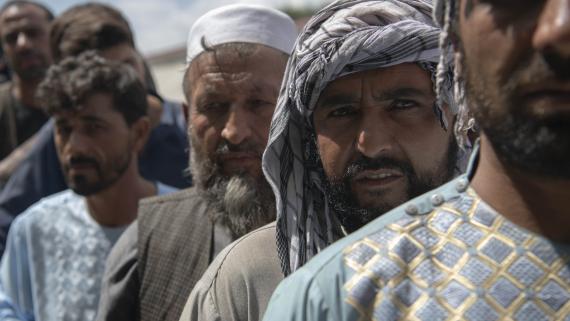Ouagadougou, Burkina Faso
This young man was selected by the Women-Young Entrepreneurs and Citizenship project (ProFeJec) to receive support from a business incubator in Ouagadougou to transform part of his strawberry production into the first local organic strawberry jam in Burkina Faso. ProFeJec aims to improve the contribution of young people and women to the sustainable economic and social development in the country. UNDP/Aurélia Rusek
Looking to 2021, nearly twice as many people will require humanitarian assistance than just five years ago. Critical gains have been made in addressing need and vulnerability through closer collaboration. The humanitarian community can continue to build on these gains by strengthening collaboration between humanitarian development and peacebuilding actors.
The COVID-19 response builds on a growing culture of collaboration across humanitarian and development actors. Resident and Humanitarian Coordinators and country teams collaborate to create a joint understanding of the immediate and long-term impacts of COVID-19. This joint analysis has also examined the drivers of need across humanitarian and development sectors. Assessments and response plans to address the pandemic’s socioeconomic impact more regularly include IFIs and complement humanitarian response efforts. Of the countries covered in this GHO, 22 also have a socioeconomic plan ready for 2021 and beyond, and Myanmar has participated in the UN Secretary-General’s COVID-19 Response and Recovery Fund to more comprehensively address the population’s humanitarian and development needs.
Countries with HRPs and Socioeconomic Response Plans
The COVID-19 response has led to a significant expansion of national social protection systems, with over 200 countries implementing such measures since the outbreak began. This has benefited over a billion people, including millions of vulnerable people across humanitarian contexts. This illustrates the importance of linking national social protection systems with humanitarian cash assistance (see Cash and Voucher Assistance for more details).
Afghanistan: evaluating needs from a joint perspective

The COVID-19 pandemic drove accelerated engagement between humanitarian and development actors in 2020. The cross-cutting nature of the response opened space for Afghanistan’s first common humanitarian-development needs analysis. Under this new approach, the Inter-Cluster Coordination Team worked with development actors to identify people who required an urgent social safety-net response from the Government and development actors. Thirty-five million people (93 per cent of the population) living on less than $2 per day were included in this response. This overlap of humanitarian and development needs was used by the World Bank to design its Dastarkhan-e-Milli programme with the Government. The programme will deliver hundreds of millions of dollars in social assistance to people in poverty, ensuring no one is left behind.
Planning for 2021 has provided another opportunity to continue strengthening linkages with development actors. An updated common needs analysis identified approximately 30.5 million people in need of some form of social assistance (IPC 2+ food insecurity, roughly 75 per cent of the population). From this group, 15.7 million will be targeted for humanitarian assistance under the 2021 HRP, while the rest will require broader assistance from development actors and the Government.
WFP/Massoud HossainiIFIs have increased development investments in fragile contexts, offering opportunities for closer collaboration to reduce vulnerability. By mid-September 2020, IFIs and multilateral development banks had pledged approximately $182 billion to assist Governments and the private sector to respond to and recover from COVID-19, focusing particularly on fragile contexts to support the immediate health response and minimize the socioeconomic impact. IFIs have increasingly repurposed funding to support the immediate response to COVID-19, complementing humanitarian response efforts.
Humanitarian-Development collaboration for nutrition: lessons from Afghanistan, Myanmar and Niger

Humanitarian-development collaboration must be strengthened at all levels, according to a joint study on humanitarian-development collaboration for nutrition2 outcomes. The report, commissioned by the Global Nutrition Cluster and Scaling Up Nutrition, covers three case studies carried out in Afghanistan, Myanmar and Niger. It describes challenges and lessons learned and gives recommendations for humanitarian and development actors at global, national and local level on how to strengthen collaboration for nutrition. Creation of space is recommended, so that humanitarian and development partners can link up and develop specific and shared nutrition objectives, and afterwards implement these through national multisectoral plans. The report also calls for strengthened inclusion and accountability with and to national authorities and communities, as well as reporting against action plans.
WFP/Aurélia Rusek
Further reading
Source: UNDP
Source: World Vision International
References
- In 2020, 235 million people will require humanitarian assistance (people in need) compared to 125 million people in 2016.
- Gentilini, Almenfi, Orton and Dale, Social Protection and Jobs Responses to COVID-19 : A Real-Time Review of Country Measures, World Bank, 22 July 2020
- Based on data from the UNFPA-World Pop-Flowminder population project for Afghanistan.
- Segal and Gerstel, International Financial Institutions’ Ongoing Response to the Covid-19 Crisis, Centre for Strategic and International Studies, 21 September 2020





